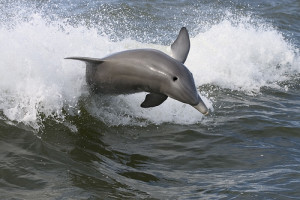We have much more to do and your continued support is needed now more than ever.
Study: Unusual Dolphin Deaths Linked to Gulf Oil Spill

This study looks specifically at the strandings between January and April of 2011–a period when a high number of near-term or newborn dolphins were found.
In a statement, Graham Worthy, a University of Central Florida provosts distinguished professor of biology and co-author of the study, identified three distinct factors contributing to the deaths, “The oil spill and cold winter of 2010 had already put significant stress on their food resources, resulting in poor body condition and depressed immune response. It appears the high volumes of cold freshwater coming from snowmelt water that pushed through Mobile Bay and Mississippi Sound in 2011 was the final blow.”
However, the new study has been criticized in some quarters for not including the toxicology reports currently being done by the National Oceanic and Atmospheric Administration (NOAA). According to the Biloxi Sun Herald:
Moby Solangi, executive director of the Institute for Marine Mammal Studies in Gulfport, said it’s too early to speculate as to the causes of the dolphins’ deaths because toxicology results have not been released. He said turtles and fish would have been the first affected by the pulses of cold water, and that did not happen.
“This is a different phenomenon,” he said. “It has nothing to do with cold water. You would have seen turtles die first. You would have seen fish die first.”
He added, “All the animals that died were responded to by us, necropsied by us and checked out by us and the government has all the tissues and will be conducting the results. They are the ones who should be writing this thing, rather than somebody who doesn’t have that data.”
Meanwhile, NOAA recently opened an investigation into the deaths of more than 120 dolphins off the Texas coast. The agency is investigating if these deaths are related to a toxic algal bloom known as red tide or if there is a connection to the dolphin strandings elsewhere in the gulf. The Associated Press reports:
… [S]ome of the dolphins washed up underweight, said Heidi Whitehead, state coordinator for the Galveston-based Texas Marine Mammal Stranding Network, a nonprofit organization that is the only authorized stranding network in Texas. Mase said that has not been the pattern for past red tide-related deaths.
Some of the dolphins also were found with discolored teeth and lung infections, prompting researchers to investigate whether they were affected by the same disease found in more than 700 strandings in the northern Gulf, an area stretching from the Texas-Louisiana line east to the Florida Panhandle. Researchers suspect the lung disease may be connected to the millions of gallons of oil that fouled the Gulf in April 2010 after a well blowout on a BP-operated rig, but have yet to make a final determination, Mase said.
There is some hopeful news for dolphins and other wildlife in the Gulf of Mexico, however. Congress recently passed the RESTORE Act, which dedicates the fines collected from BP and other parties responsible for the 2010 Gulf oil spill to restoring the Gulf Coast’s wildlife, environment and economy.
Over the coming months, the National Wildlife Federation, together with wildlife advocates across the country, will be working hard to make sure Gulf states and the Obama Administration ensure that every dollar is used to help restore the Gulf and increase the resiliency of its ecosystems and communities.






















